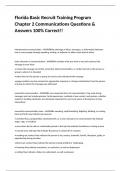Florida Basic Recruit Training Program
Chapter 2 Communications Questions &
Answers 100% Correct!!
interpersonal communication - ANSWERthe exchange of ideas, messages, or information between
two or more people through speaking, writing, or behavior to affect some kind of action
basic elements of communication - ANSWER• consider what you want to say and construct the
message in your head
• convey the message via verbal, nonverbal, telecommunication, or written format to the person or
group to whom it is intended
• allow time for the person or group to receive and understand the message
• gauge weather one has received an appropriate response or change and behavior from the person
or group to whom the message was addressed
nonverbal communication - ANSWERIs very important form of communication. May send strong
messages and can include gestures, facial expressions, methods of eye contact, and posture, whether
seated or standing. Behaviors are extremely important for you to be aware of during face-to-face
interactions.
nonverbal communication clues - ANSWER• sweating, rapid breathing, fidgeting, blinking, or rocking
back and forth may indicate nervousness
• clenched fists, pacing briskly, clenched teeth, or a clear reluctance to communicate May indicate
anger, rage, or irritation
• arms down by the side or comfortably placed in the lap May indicate friendliness or being at ease
• crossed arms and legs May indicate the person is closed off or resistant
• avoiding eye contact May indicate the person is shy, uneasy, shameful, fearful, deceptive, guilty, or
experiencing strong emotion
• Direct eye contact May indicate the person is being truthful or challenging
• frowning May indicate uneasiness, or confusion, as well as displeasure
• smiling May indicate a failure to understand, as well as pleasure
, • lack of obvious emotion May indicate shock, fear, poor understanding, not being focused, or not
hearing
barriers to effective communication - ANSWER• use of profane, derogatory, or disrespectful language
• stereotyping
• use of derogatory hand gestures or body movements
• stress and fatigue on the part of either party
• inability to communicate in the same language
• lack of cultural understanding
• failure to listen actively
• use of jargon
• tone of voice
• negative attitude
• environmental distractions such as background noise
diversity of population - ANSWERYounger inmates
Older inmates
inmates of the opposite sex
command presence - ANSWER•positioning and posture
• face inmate directly and look him or her in the
• conveys that you are focused and attentive, but in charge
• stand upright, eliminate distracting behaviors, and incline yourself slightly forward
• project confidence, poise, and a professional demeanor
verbal command - ANSWERis an authoritative statement used to direct, influence, or give orders to a
person or group
courtesy - ANSWERis being respectful when interacting with others and treating them in a dignified
Manor, regardless of their status, race, gender, appearance, or behavior
• maintaining a professional and ____?___ relationship is important because this may help you avoid
or de-escalate potentially violent situations




